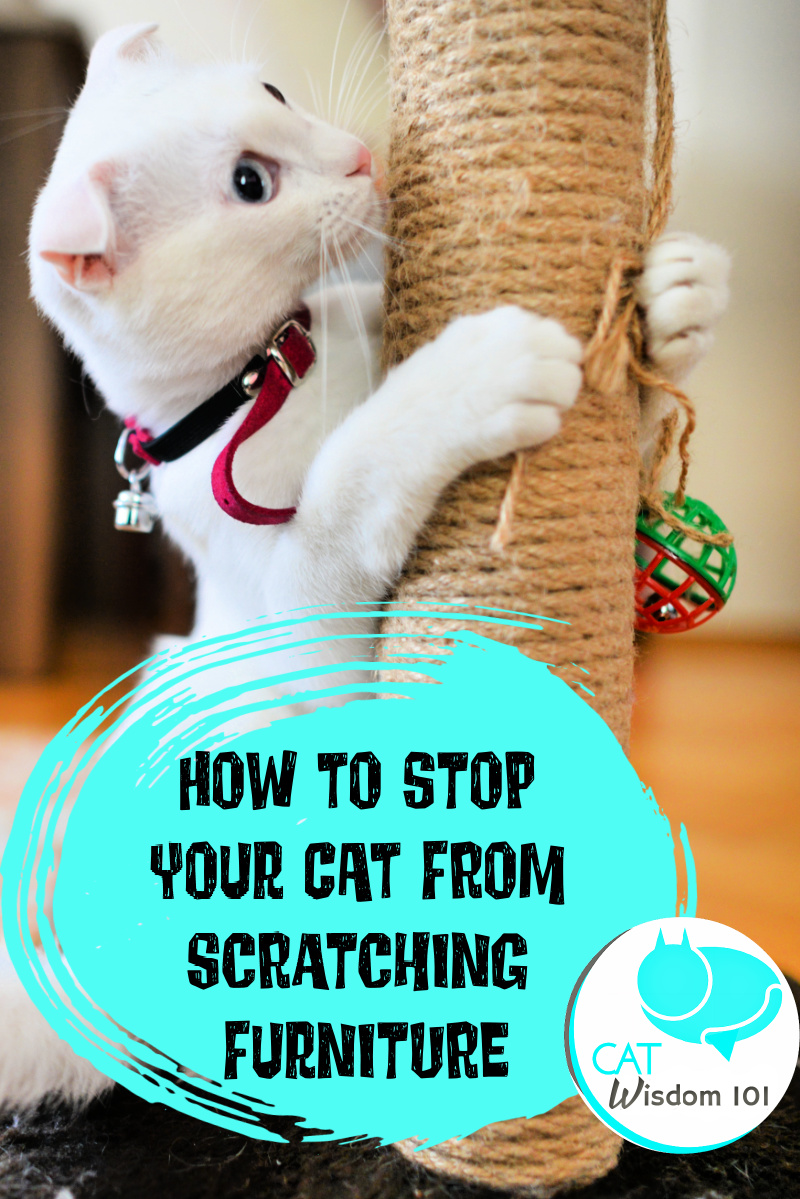
How to Stop Your Cat From Scratching Furniture, Naturally
Scratching is a natural and instinctive behavior in cats. It helps them stretch their muscles, sharpen their claws, and mark their territory. Yes, you can stop cats scratching furniture naturally. Here’s how.
Our adorable and lovable cats can turn into little destructive demons but, it doesn’t have to be that way. Cat will scratch furniture, carpet, rugs, table legs, door jambs, you name it. It’s impossible to predict what any cat will prefer. Hard surface, soft surface, synthetic fiber, leather or plastic but they will have a preference. They don’t care if it’s a valuable heirloom so never punish a cat for unwanted behavior. It won’t help and likely create more issues.
OBSERVE CATS In The Wild. What, how and where do they scratch.
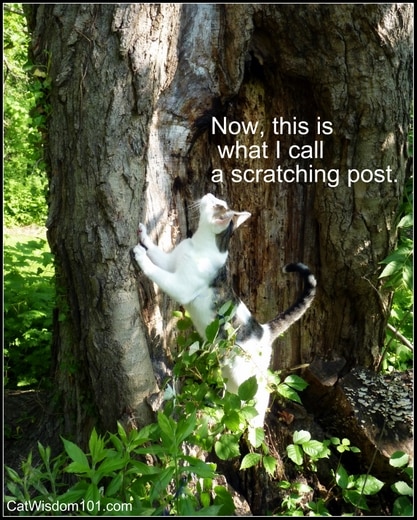
I’ve blogged about countless cat scratchers over the years and nothing beats a real tree. Not just any tree but one selected by the cat. Our Odin has every kind of scratching post indoors and scratches numerous trees outdoors but loves one small tree outside the house. For him it’s the goldilocks of trees. Not too big, not too small but just right.
My OTRB cats Gris Gris and Domino were obsessed with tree roots, weren’t big tree climbers and not surprisingly, preferred flat cardboard scratchers.
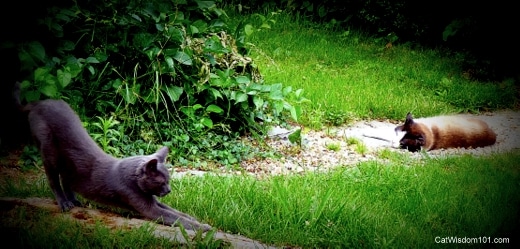
If you have an indoor-only cat, observing how, where and when your cat scratches will help determine the best action plan.
Here are some tips on how to stop cats from scratching your furniture or anything else.
- Provide a scratching post or pad: A scratching post or pad the best alternative to your furniture. It can satisfy your cat’s scratching needs without damaging your furniture. BUT it must be the right one for your cat. If your cat is vertical scratcher, a flat mat won’t do. It might take trying a few different kinds to find the best one. I’ll include Amazon links to some of my favorite ones.
My all time favorite is the classic Bergan scratcher and toy. Odin uses it daily. The original plastic part must be 12 years old by now (see old photo) and thankfully the cardboard inserts are sold separately. It’s small, portable and genius for enrichment and scratching. Odin likes to slide it across the floor but if your prefer, place it on a carpet or rug to keep it from sliding.
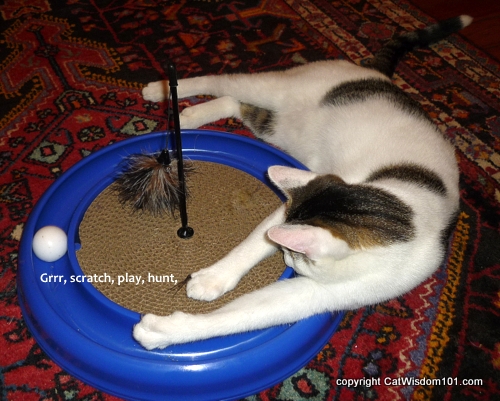
The cheapest scratcher I could find is a hanging one. They work fine but if you don’t want to it swinging around, use double-sided tape. You can also use it flat on the floor.
Think out of the box. You might already have items or materials at home that could be repurposed for scratching or for a DIY project.
In 1995, I adopted two Siamese kittens. In those days, we didn’t have the huge variety of cat products. Before long, the kittens scratched the carpet on the stairs but soon preferred my Parson’s chair legs. They were upholstered in thick textured velvet and having 16 of these legs was cat tree heaven. Cats being cats, had their favorites. These were expensive custom designer chairs and I had to come up with a solution.
Four of the legs were getting well used. I didn’t know at the time that aversive techniques like water bottle spraying didn’t work. Covering the legs with aluminum foil worked but they simply scratched the uncovered one. I lived with it until two of the legs were threadbare. Then, eureka! Slipcovers. I had them custom made but generic ones are easily available. They were a perfect solution until I retired the chairs last year. The cats loved crawling underneath the cover to scratch the legs. Win win.
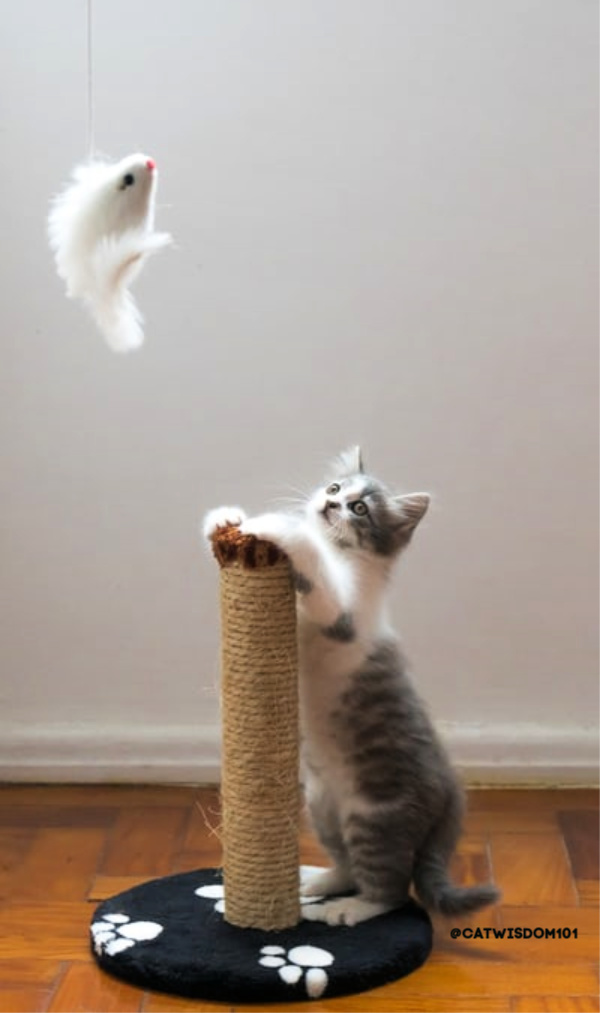
Scratchers are usually sisal rope, carpeted or corrugated cardboard and come in every possible size from small hanging ones to huge multi-level kitty condos. I’m not a fan of the cheap, synthetic carpeted scratcher/condos because they off-gas chemicals and frankly I think they’re ugly. There are some cute ones, if that’s your taste and better than nothing. This foliage one is cute and blends into a decor without scream cat scratcher.
If you like more furniture-like scratchers, I’ve had this one for years. It’s incredibly well made and sturdy and worth the price.
Cardboard, depending on use, lasts about a year but I still have Katris that are 10 years old. They aren’t cheap but durable.
I have this configuration and there are a million ways to arrange it to satisfy both vertical or horizontal scratching preferences.
Don’t skimp on the really cheap ones. This is well made and good value.
I posted about KatKabins 11 years ago! Every spring, I like moving things around during a big spring cleaning, found the old Kat Cabin. I hosed it down (it’s waterproof) and guess what? It’s back in the livingroom and Odin’s favorite when not scratching outdoors. I’m shocked at how new it looks. Built to last for sure.
I recommend placing the post or pad near the furniture that your cat likes to scratch. Choose a post that is tall enough for your cat to stretch and sturdy enough to support their weight. Remember, observe your cat. Do they like to scratch on an angle, flat on the floor or stretch vertically. If you have a cat that loves climbing, There are vertical floor to ceiling pole scratchers that don’t take up much floor space.
- Placement of the scratcher is key to success. Location. Location. Location.
- You can place it near the object it currently likes to scratch.
- Near an interesting area like near a window for bonus viewing.
- Avoid high traffic areas, near the litter box or any undesirable location they avoid.
Encourage your cat to use the post or pad by placing treats or catnip on it. If your cat doesn’t respond to catnip, use their favorite treat.
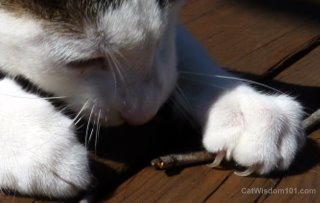
2. Trim your cat’s claws:
Trimming your cat’s claws regularly can reduce the damage they can cause to your furniture. Use a cat-specific nail clipper and be careful not to cut the quick, which is the pink area in the nail that contains blood vessels and nerves. If you are not confident in trimming your cat’s claws, seek advice from your veterinarian or a professional groomer.
Dr. Susan Nelson, a clinical professor at the Veterinary Health Center at Kansas State University, says, “Trimming your cat’s claws every few weeks is a good way to reduce the amount of damage they can cause to your furniture. It can also help prevent your cat from getting their claws stuck in fabrics, which can be painful and stressful for them.”
You can also use claw covers, such as Soft Paws to cover your cat’s claws and protect your furniture. It’s not my favorite choice but they work.

3. Use deterrents: Make the furniture unappealing. Cover furniture: Covering your furniture with a blanket or a throw can protect it from scratches. Choose a cover made of a material that is not easily destroyed by cat claws, such as microfiber or leather. You can also use double-sided tape or aluminum foil to make the furniture less appealing to your cat. If you have a leather couch or chair, use a cover made of a durable material that is not easily punctured by cat claws. If your cat is still scratching the cover, try spraying it with a scent that is unpleasant to cats, such as citrus or vinegar.
There are several products on the market that can help deter your cat from scratching your furniture. These include sprays, tapes, and mats. These products work by emitting a scent or a sound that is unpleasant to cats or by providing an unpleasant texture for them to scratch.
I’ve used different kinds of tape. They work but unless there is a desirable alternative like a good scratching post, the cat may scratch an uncovered area of the furniture.
If you’ve tried everything, a motion activated sound is a deterrent worth considering.
I’ve had mixed results with bitter tasting or citrus type sprays. It’s either going to work or not. They aren’t expensive and worth a shot.
Before using any deterrent product, make sure it is safe for your cat and does not contain any harmful chemicals. Test the product on a small, inconspicuous area of your furniture first to ensure it does not cause damage or discoloration.
4. Use positive reinforcement: Encourage your cat to use the appropriate scratching surfaces by rewarding them with treats or playtime when they use them. You can also place toys or catnip near the scratching surfaces to attract your cat to them. Redirect unwanted behavior i.e throw a toy to get their attention, gently bring them to the scratching post and reward with a treat if they use it. Never yell or hit a cat to make them to stop. It not only won’t work but reinforces the behavior.
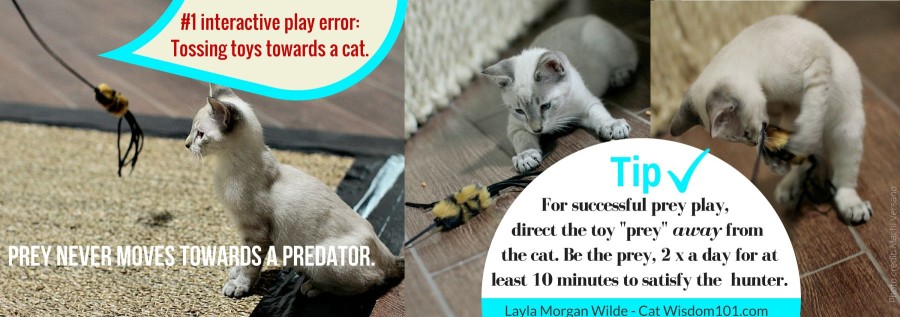
Are Playing With Your Cat All Wrong?
Play with your cat: Playtime can be an effective way to redirect your cat’s scratching behavior. Use toys, such as feathers, balls, or strings, to play with your cat and provide them with an outlet for their energy. This can also help strengthen your bond with your cat and reduce their stress levels.
Playing with your cat regularly can help them burn off energy and reduce their desire to scratch. Make sure to provide plenty of toys and rotate them regularly to keep your cat engaged and interested.”
Supervise your cat: Keep an eye on your cat and redirect them to appropriate scratching surfaces if they start to scratch furniture. If your cat continues to scratch furniture, you may need to limit their access to the area or use a deterrent spray.
Remember that training your cat takes time and patience, but with consistent effort, you can teach your cat to use appropriate scratching surfaces and protect your furniture.
Do you have a favorite scratching product or tip to share?



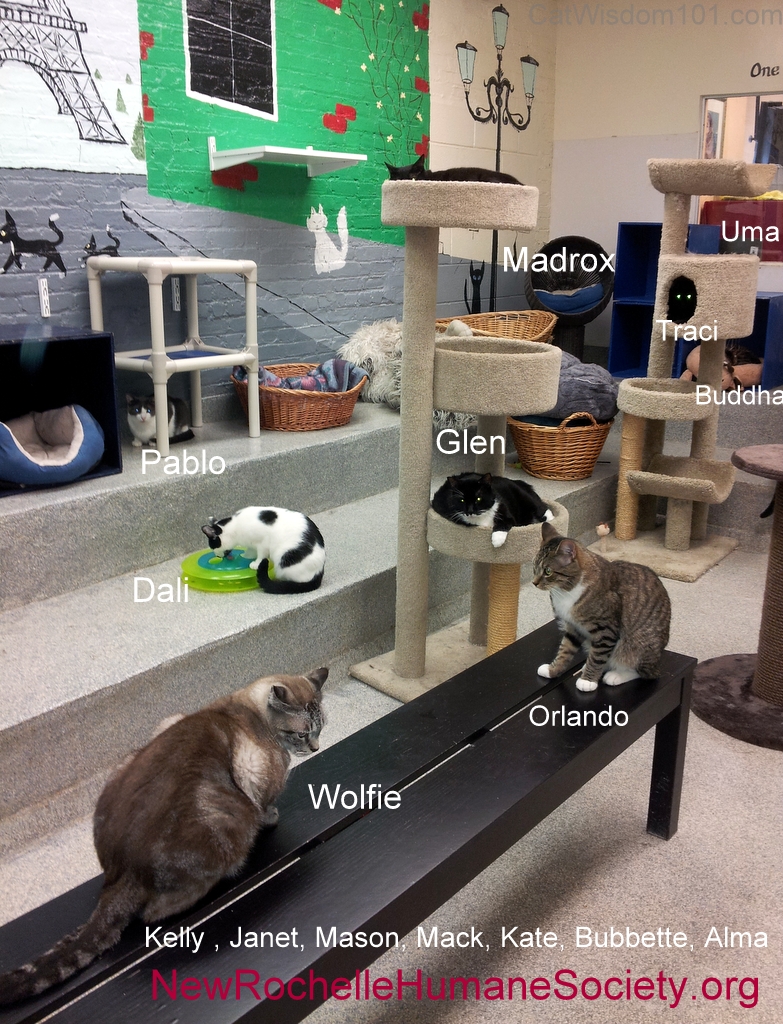


8 Comments
Skeeter and IZZY
So much great info as usual!!!!
My guys really dig it when a package arrives and I tape the box closed after oprening it. They shred it trying to get it open and then lay in it when successful…………..multipurpose item LOL.
Luvs
Skeeter and IZZY and the Feral Gang and the Angels >^..^^..^<~
Amy Harlib
Astor-kitty never wants to use the nice commercial cardboard or hanging sisal cat scratchers I had bought. Instead he only likes to scratch the wood of the drawers under my loft-style bed.
Fortunately, I do not really mind. As long as he does not rip up my thousands of books on the book shelves!
I love that cat so much, he can scratch where he pleases!
Meezer'sMews&TerrieristicalWoofs
I put a three sided tall scratcher near their favorite napping spot, which was used when they woke up. When it finally fell apart; (I broke it, oops). I attached one side to a cat lounger and hung another on a door knob. They still used them.
Andrea
Oh wow, I just watched that video too and now I see how to make a DIY cat scratcher! I’m sure I can do that. I already have the scratcher, the sisal has all been scratched off so all I need is the sisal, a couple of screws and a glue gun. Yay!
Oh, and thanks for the link to KatKabins too, I won one years ago when they first came out and used it outside for the ferals and it is in pieces now after being exposed to the on/off cold for many years. It did it’s job so I guess I’ll have a funeral for it. Those new ones with the scratching surface are so cool.
Andrea
The very first cat tree I got in a raffle had tree branches with bark attached and carpeted levels. My cats still love it. It has been through many generations of cats and is still there in my front window. They don’t make that kind anymore unless they are made in your own state because of regulations meant to prevent transfer of pests (termites, emerald ash borer, etc.) from one state to another.
I also don’t have a lot of furniture for them to scratch but a lot of trees and a lot of cardboard scratchers. I’ve noticed Gooseberry like to scratch on a slight incline. You are so right, observation is key.
I love this post. Thanks for your thoroughness, Layla.
Layla
Thanks Andrea, you’re right about the natural posts and insects. I found some treated ones that are available but pricey.
Erin the Cat
I think this is the best article on scratching I’ve seen. Finding a think and not easily pierced fabric has been key for us.
ERin
Layla
Thanks, Erin. Did you find the fabric?